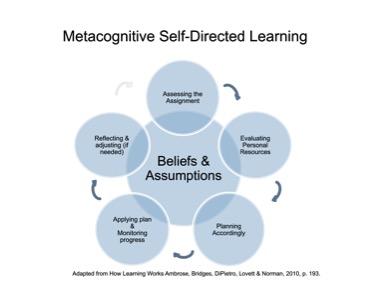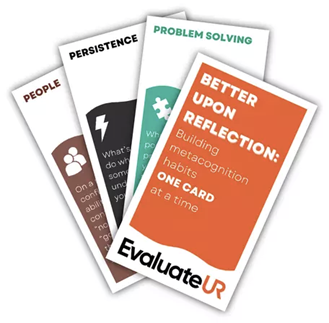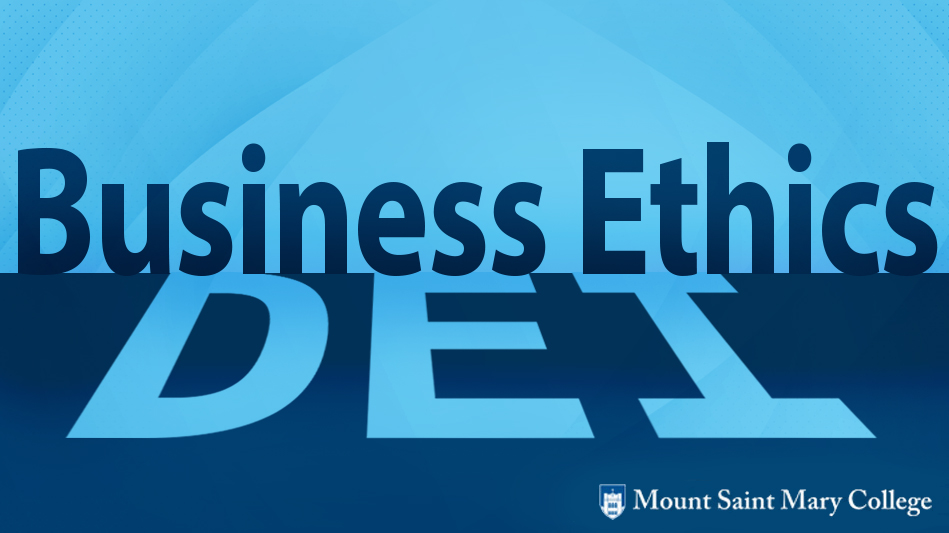Dr. Christina Hardway, Professor, Department of Psychology, Merrimack College
(Post #2: Integrating Metacognition into Practice Across Campus, Guest Editor Series Edited by Dr. Sarah Benes)
Helping students to become self-directed learners is, arguably, one of the most important outcomes of education. Self-directed learning is proposed as a circular (and iterative) process. It involves making a plan, monitoring one’s progress, and then making changes or adapting as needed. These behaviors occur within the context of one’s beliefs about learning and abilities to succeed (see figure, adapted from Ambrose, et al., 2010).
Helping students to build better metacognitive skills during their regular coursework is important (see Education Endowment Foundation, 2020). This is, perhaps, because metacognitive knowledge (e.g. cognition about cognition), is a relatively abstract concept. Learning theorists like Jean Piaget suggest that learning concrete concepts occurs before learning abstract principles. For this reason, I believe that it is important to provide students with explicit tasks embedded in their courses so that they can practice these skills in order to build this more abstract and flexible set of metacognitive competencies.
This blog post shares activities and suggestions to help students build more metacognitive skills and become better self-directed learners as they complete a challenging, semester-long writing assignment.
Beliefs and Assumptions
I have taught a writing intensive research methodology course for many years, and the work in this course lends itself to an embedded approach to teaching metacognitive skills. It also presents an opportunity to help students examine their implicit attitudes toward learning and writing. Students come to the classroom with ideas about themselves as writers and may labor under notions like, “I am not a good writer” or “I have to wait until the last minute to start, because that is when I do my best work.” It is within this context that teaching students explicit and concrete ways to self-regulate their learning of the writing process is helpful. Providing activities throughout the semester helps students adjust these beliefs and build better writing practices, which can help them to not only convey their ideas, but also learn from that writing process.
Additionally, the kind of writing required in research courses is often novel for undergraduate students. Many students enrolled in the course are in their second or third semester of college and have never written a long research proposal. Their assumptions about how to approach this task are, therefore, not always aligned with the requirements. Many students also experience anxiety when faced with an assignment like writing an extensive research paper for the first time. As a result, the assignment of writing a long research proposal, as they are asked to do in this course, provides an opportunity to practice the emotional regulation skills required to successfully manage their intellectual endeavors.
Activities to guide the process of self-directed learning
For each phase of this self-directed learning cycle, I include prompts to guide students to explicitly consider their (often) implicit assumptions about the way they work. Each of these activities gives students the opportunity to reflect on their understanding of the writing process and build better metacognitive skills. Sometimes, these activities are presented in a free-writing exercise, and I commonly divide students into smaller groups to discuss their responses and then report back to the group. This sharing allows students to see that their peers often experience the same struggles during the writing process, and they can offer one another advice or support.
Assessing the assignment. With the permission of previous students, I provide examples of completed work to new students, together with my own annotations, highlighting places where and how requirements were met. This gives them a concrete understanding of what to accomplish. Additionally, I provide a detailed rubric that I review with students multiple times so they can continually compare their progress with the final expectations of the assignment.
Evaluating personal resources. I prompt students to evaluate their personal resources as writers, early in the course. To accomplish this, I ask them to reflect on their approach to writing by responding to questions like: “Please tell me a bit about your writing process and a few ways you would like to improve as a writer” (adapted from Dunn, 2011). This reflection invites them to step back from the immediate tasks and see their work as connected to their development as scholars, writers, and learners.
Planning. To help students make appropriate plans for completing a long multi-step assignment, I ask them to develop a concrete work-plan, as well as to discuss these plans with others. Two kinds of conversations can facilitate this process. One set of prompts gives students a chance to make specific plans to complete their work, including questions like, “Identify times you can complete this work” and “How much work will you complete at each time?” The other set of prompts are designed to scaffold their intellectual development. Through small-group conversations, students describe their research ideas to other students, with instructions like this: “Please describe your research interest. This is an opportunity to discuss your research ideas with someone else. Talking through your ideas is a good way to not only receive feedback, but also, it gives you a sense about which things are clear to you and which concepts need more clarification.”
Applying & Monitoring. I also ask students to write drafts of sections of this larger paper and to visit a writing fellow in our College Writing Center to discuss them. To help students monitor their progress, I have asked them to complete reflective activities after tutorial sessions, including questions like, “Please describe what you learned about the writing process in your meeting.” and “Please describe AT LEAST three specific revisions for your paper, based on your meeting with the Writing Fellow.”
Reflecting & Adjusting. Several reflective opportunities embedded in the course help students to adjust their approach to writing.
- Peer review reflections: At the more immediate level, I ask students to engage in an intensive peer-review process, whereby they read each others’ papers to provide specific feedback. This process of helping others to improve their writing often provokes them to reflect more broadly on the writing process. I ask students to use the paper’s grading rubric, as well as a series of questions that help them to think about ways to evaluate whether the paper under review meets the criteria. For example, I ask them to notice if they need to re-read a passage to understand the author’s point, as this might indicate revision is warranted. After peer-review, students engage in conversations about what they have learned from the process, and I also ask them to identify at least three specific changes to their papers they should focus on next. By providing this feedback, students must step back and think about what makes writing successful, and our subsequent discussions facilitate the development of metacognitive knowledge.
- Personal growth reflections: A second set of reflective activities were suggested by our Writing Center and are designed to help students consider the broader ways in which they have changed as writers. These include questions like, “Please consider the different phases of this assignment and discuss what you have learned about writing. ” and “What are the ways you have improved as a writer? What are some ways that you would like to improve in the future?” This combination of fine-grained, detail-oriented and bigger picture questions is intended to help students develop fundamental metacognitive skills and also a more nuanced understanding of metacognition for their identity as learners and writers.
The self-directed learning cycle is a circular process whereby students bring the skills they learn in one course to their next endeavors. Through this process of sharing and reflecting, they build their metacognitive skills and become more comfortable with their inchoate ideas and compositions. Hopefully, students are then able to transfer these skills into future courses and into their lives outside of academics as well.
References
Ambrose, S. A., Bridges, M. W., DiPietro, M., Lovett, M. C., & Norman, M. K. (2010). How learning works: Seven research-based principles for smart teaching. Jossey-Bass.
Dunn, D.S. (2011). A Short Guide to Writing about Psychology (3e). Boston: Pearson Longman.
Education Endowment Foundation (2020). Metacognition and Self-Regulated Learning: Guidance Report. Retrieved on July 7, 2021 from https://educationendowmentfoundation.org.uk/public/files/Publications/Metacognition/EEF_Metacognition_and_self-regulated_learning.pdf




